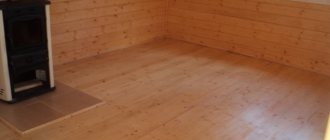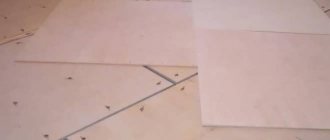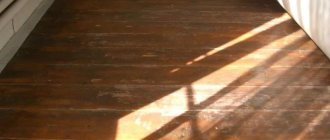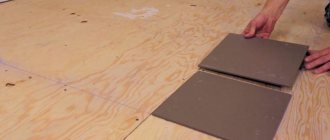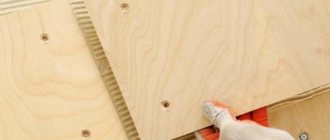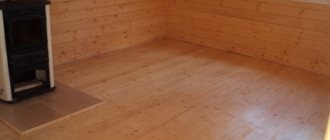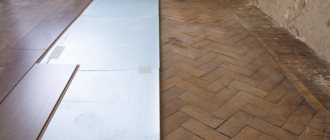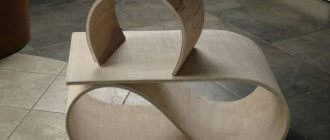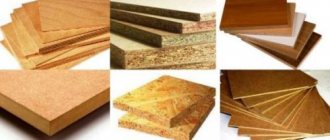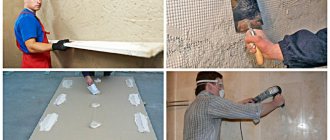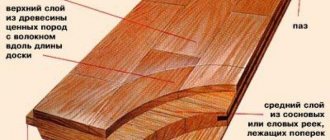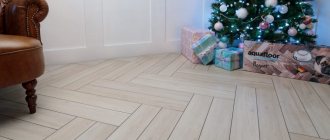Plywood over wood floors in your home allows you to level the base without dismantling the old wood flooring. The backing in this case prevents squeaking and other problems that may arise. The technology allows you to do the installation yourself without any serious difficulties.
Laying plywood over a wood floor is a great solution. This DIY rough coating has the following advantages:
- low cost;
- ease of transportation;
- reduction of preparatory work time;
- good leveling of small floor defects and increasing the service life of the floor covering;
- strength and wear resistance of the material;
- flexibility, which allows it not to break or crack during operation and installation;
- minimum number of joints between sheets;
- installation is carried out without serious labor costs.
Before laying the material with your own hands, you need to choose it correctly. There are several classifications based on various criteria:
Laying plywood on a wooden floor in a house (subfloor) involves the following recommendations for choosing when doing the work yourself:
- the flooring is made from sheets of the second or third grade, the use of the first is not justified from an economic point of view;
- It is best to use moisture-resistant material in the house, this is especially important when installation is carried out in wet rooms (bathroom, toilet, kitchen);
- flooring involves the use of sheets with a minimum thickness of 10 mm, but this is only suitable for small rooms with low traffic;
- laying technology in more critical premises assumes that the substrate under the finished floor will be made of a material with a thickness of 14-22 mm, such sheets have sufficient strength;
- It is recommended to choose materials sanded on both sides (if possible).
Plywood underlay on wooden floor |
Glory to the creators Laying sheets of plywood correctly should be in a checkerboard pattern, i.e. Simultaneous joining of no more than 3 seams is allowed.
Expert opinion
Strebizh Viktor Fedorovich, leading construction foreman
When choosing the size and type of plywood for installing the base for the final floor covering, you should take into account the following parameters: If you want to clarify something, please contact me!
Plywood: advantages and disadvantages of the material
Pressed sheets are an excellent material for rough and primary work. They are inexpensive, easy to transport, easy to install and are good at eliminating small differences in floor level. Often they prefer to lay linoleum, parquet boards or laminate on plywood, since it has the following advantages:
- laying sheets significantly reduces the time of preparatory work before installing the final finishing floor covering;
- prevents rotting of the underside of floor coverings due to good ventilation between the material and the concrete screed;
- a floor lined with plywood prevents premature wear or deformation of linoleum or carpet, extending the life of the decorative coating;
- provides a smooth subfloor;
- plywood sheets are light, hard, durable, resistant to stress and abrasion;
- plywood is flexible enough and does not break during installation;
- has no pungent odor;
- has good sound and heat insulation properties;
- due to the large size of the sheets, the number of joints is minimal;
- high-quality factory grinding prevents slipping of the sheet and materials placed on it.
Causes of uneven wooden floors
During the flooring process, wooden joists are initially installed, which will serve as a level base for the flooring. Then a strong thread is stretched between them, which will serve as a beacon for installing the remaining logs. The outermost joists must be installed at the same level, otherwise the floor will have a slope.
If the distance between the joists is incorrectly calculated, for example, if the distance between the joists is too large, deflections may appear in the floor covering.
When installing the base, you need to pay attention to the correct fastening of the logs; if the logs are not fastened enough, they can shrink, which will also lead to sagging of the wood
When choosing wood, you need to pay attention to its moisture content. The board should not be overdried or too damp.
The influence of air temperature and humidity in the room can also cause uneven floors. As humidity increases, a wooden floor increases in size, and as it dries, it contracts. Over time, this can cause gaps to appear between the boards.
If the wood is not treated with antiseptics and paints, this also leads to deformation or even destruction of the floor coverings.
When laying a floor, its hydro and thermal insulation plays an important role. Correctly selected waterproofing materials will ensure the floor is dry, and, therefore, will significantly affect the period of its quality operation.
Popular types of plywood used for renovation
Sheets produced by industry are classified according to various criteria:
- wood used;
- presence and method of impregnation;
- variety;
- number of layers;
- surface treatment;
- moisture resistance.
| Brand | Moisture resistance level |
| FSF, FSF-TV | increased |
| FSB, BFS, BFV-1 | high |
| BP-A, BP-V, BS-1 | above average |
| FBA, FC | small |
For repair work, when the part of the structure made of plywood will be hidden from view, it is recommended to use moisture-resistant plywood of grade II or III. The sheet must be at least 10 mm thick, but the recommended value is 14-22 mm. A thinner one will not cope with the load, and a too thick one will be inconvenient to work with.
Plywood thickness and ply
The number of layers is not of fundamental importance. If possible, you should purchase sheets sanded on both sides.
- If possible, the plywood should be dried for 2-3 weeks before starting work. The sheets are dried vertically, at a temperature slightly above room temperature.
We bring plywood into the room
You can increase the strength of plywood using several layers of acrylic varnish
48 hours before the start of work, the material must be brought into the room where it will be installed and laid horizontally. There are two ways to lay plywood.
How to insulate a floor with penofol with your own hands, installation technology, video diagram
Penofol is an effective thermal insulation material that has low thermal conductivity and reliably protects homes from the cold even when laying a thin layer of material. It is often used for floor insulation, since due to its special properties, penofol increases heat transfer resistance.
Scheme of laying penofol with the reflective layer down.
Penofol can be perfectly combined with mineral wool and fiberglass when insulating floors, where it will serve as a vapor barrier. The use of this material will be appropriate in those structures that require not only thermal but also noise protection, but the thickness of the insulator should be minimal. To insulate a floor with penofol, you do not need to additionally use hydro- and vapor barrier membranes, since the material can become a replacement for them.
Penofol classification
Since the production of penofol began, its properties, scope of application and structure have undergone enormous changes. Previously, the material took the form of a roll of cross-linked polyethylene foam, one side of which was foiled with aluminum. This type of material is still used to insulate rooms, as it is highly efficient. In addition to the classic type of penofol, other types of material are produced, which are endowed with a number of useful properties:
Scheme of floor insulation with penofol with double-sided foil.
- With one-sided foil - type “A”. Used in conjunction with other materials for insulation.
- With double-sided foil - type “B”. Standalone use is allowed.
- Type “C” - one side is covered with special glue and protective film, and the other is covered with foil. Installed by gluing to a surface that requires insulation.
- Types “R” and “M” are embossed penofol with one foil side.
- Type “ALP” - has one-sided foil up to 14 microns, which is laminated with polyethylene film.
- Perforated material. It has a special structure that allows air to pass through.
The type of penofol is selected depending on the type of insulation work, i.e. walls, floor, roof.
Penofol laying technology
Penofol characteristics table.
Before insulating the floor with insulating material, you need to decide on its type and installation technology. Penofol types “C” and “A” must be laid under the finished floor. The insulation process begins with a concrete screed mixed with expanded clay, or with the placement of foam plastic slabs with a thickness of 5 to 10 cm. Next, penofol is laid with an overlap of about 10 cm and all joints are taped with construction tape.
It should be noted that condensation may settle on the thermal insulation material, so measures must be taken to prevent this phenomenon. To do this, fill slats up to 2 cm thick above the foil surface, which will create a ventilated space. If a wooden floor is being insulated, then the role of slats is played by logs
It is important to remember that all slats and joists must be impregnated with antiseptic and drying oil to protect the wood from rotting
If insulation is carried out using a “warm floor” system, then penofol is laid with the foil side down on a completely dry screed, and in other cases the material must be placed with the reflective side up. A polyethylene film is spread over the heat insulator, which will act as a vapor barrier. To insulate the floor on the lower floor located above the basement, type “B” penofol should be used.
As a rule, when installing a “warm floor” system, the heating elements must be filled with screed in order to subsequently obtain a flat surface for laying, for example, laminate flooring. In such cases, the “ALP” type of penofol should be used, since its foil side is laminated with a film, and, as is known, cement is aggressive towards aluminum.
Floor insulation with penofol of this type is performed on top of the primary screed, with the reflective side being on top. The sheets are laid with a slight bend, about 10 cm, on the walls and they are glued with aluminum tape. Next, heating elements are installed, a reinforcing mesh is laid, and the entire floor area is filled with concrete screed. When the surface is completely dry, it is necessary to trim the free edges of the insulation.
Using penofol for floor insulation is the best solution. With this material, moisture will not penetrate into the room, noise will decrease and it will become much warmer, since the foil surface reflects heat, directing it back into the house.
Method 1. Installation on old wood flooring
When laying plywood on a wooden floor, there are many options for fixing the sheets:
- on self-tapping screws;
- on glue;
- for liquid nails.
Adhesive compositions include water-based adhesive, two-component adhesive, assembly adhesive and bustylate. However, fastening with self-tapping screws is preferable.
Materials and tools
To successfully install plywood sheets, you will need the following tools and materials:
- plywood sheets;
- jigsaw;
- level;
- roulette;
- marker;
- self-tapping screws;
- screwdriver;
- substrate;
- construction vacuum cleaner or broom.
You may also need a sanding machine, a roller and primer, glue and sealant.
Preliminary preparation and priming of the floor
Installation of plywood on wooden floors is carried out only if the height difference when checking the level is no more than 1 cm. In this case, you will also need a substrate to compensate for unevenness and tape, which will need to be used to glue the joints of the strips of material.
Inspect the condition of the floors. Strengthen creaking and loose floorboards, replace rotten and damp floorboards. Do not try to restore boards that have traces of mold, damage, or have been attacked by rodents. They definitely need to be removed and the room ventilated.
We remove the baseboards and inspect the condition of the floor
Use a broom to sweep away dust and dirt from the floors. If desired, go over the wood surface primer twice to ensure better adhesion of the materials. And dry the base for at least 16 hours.
Marking and cutting
Only saw plywood on a rigid base
Plywood sheets are sawn so that the number of joints is minimal, taking into account damping joints of 3-4 mm between sheets and 8-10 mm between plywood and the wall. This will help avoid swelling of the sheets, since during operation, under the influence of the microclimate and temperature fluctuations, the workpieces will increase in area by several millimeters.
Creating a plywood base for laminate
A specific type of plywood is used to lay laminate flooring. This is a requirement for safety measures, since there are several types of material:
- The FOF plywood marking means that it can emit harmful substances and is suitable for use only in industrial facilities.
- FSF plywood has high moisture resistance. However, its use is limited. The maximum place where it can be used is in boiler rooms and utility rooms, since the impregnation glue releases harmful substances.
- Only material marked FC is allowed for use in residential areas.
However, not all FC plywood is ideally suitable. To understand which plywood for laminate will retain its properties the longest, you should remember that pine dries out over time and begins to rot. The best choice would be FK brand plywood made from birch.
The thickness of the plywood under the laminate is selected based on the characteristics of the base. An 8 mm sheet can be laid on a hard and durable floor, but a deformable base will require 10 mm. If plywood needs to take on most of the load, you can increase the thickness of the sheet to 12-16 mm.
Laying plywood is quite simple. To prevent deformation due to changes in humidity, the flooring is made with gaps. To work you will need:
- jigsaw;
- saw with small teeth of low height;
- pencil;
- roulette, rule for marking.
The installation process is carried out in several stages:
- each sheet is cut into 4 parts;
- preliminary placement is carried out;
- the gap between the elements should be 5 mm, to the walls - 10-15 mm;
- the parts are trimmed, the necessary cuts are made, and the final shape is given;
- all plywood segments are numbered;
- the lower part is impregnated with bitumen mastic or elastic construction adhesive;
- parts are placed in place according to numbering and maintaining clearances;
- fastening is done with screws.
The work can easily be done with your own hands. Upon completion of installation, the surface is treated using a grinder with coarse sandpaper.
Laying laminate
Before the installation process, the laminate must be acclimatized. Unpacked boards are left indoors for at least 48 hours. After this, the material is ready for use. Laying is carried out according to the instructions for the specific type of coating. One example is shown in the video. To work you will need:
- pencil for marking;
- a square along which the cut will be marked;
- a jigsaw with a saw with a very fine tooth pointing upward;
- plastic block;
- rubber mallet or mallet.
Since the process of laying waterproofing, the substrate and the laminate itself is carried out according to the instructions, there are rules that must always be followed.
- The gap to the walls should be 5 mm. Wedges can be used.
- It is necessary to tap the strip only through a plastic block, so as not to damage the board or the surface of the laminate.
- Marking is done from the back side. The cut is made by placing the part with the markings facing up. The jigsaw feed is minimal.
- If the length of the room requires joining the boards lengthwise, move each next row of laminate by 40-45 cm. This will not only provide a better look, but also guarantee greater safety for wet cleaning.
- You cannot lay laminate flooring with glue. Plywood and coating are moisture-dependent, and when the humidity level in the room changes, they expand unequally.
If you follow these simple rules, you can lay laminate flooring perfectly with your own hands. The result of this work is shown in the photo.
Method 2. Installation of plywood on joists
A more complex and labor-intensive method of laying plywood material along beams is justified if the height difference is more than 1 cm. Joists can be installed on an old wooden floor only if you are sure that everything is in order under it
Preparatory stage
The old floor was dismantled
Old flooring must be removed from dust and debris, paying sufficient attention to the gaps between the floorboards. The largest cracks can be filled with silicone sealant or assembly adhesive.
At this time, you should prepare the plywood - you need to saw the material, make markings on a piece of paper and number the squares, taking into account that they will be laid out in bricks.
Installation of logs and plywood sheets
Find the zero level and set the first lag
Installation of the first floor joist
Installation of subsequent joists
Logs laid in the form of a lattice
Logs are guides that help level the floor surface. They are slats 1.5-2 m long and 40x15 mm in cross-section, which are attached to wooden boards with dowels or self-tapping screws. The logs are positioned in such a way that their upper boundaries form a single plane, and the slats themselves form a sheathing.
We attach sheets of plywood to leveled logs
Installation of plywood on joists
The spaces between the guides must be filled with soundproofing insulation.
If necessary, cords and communication wires can be hidden in layers of insulation.
Scheme of laying plywood on logs with insulation and laying communications
According to the drawing, the plywood squares should be installed. Fastening can be done with liquid nails or self-tapping screws; in the latter case, the heads of the screws must be thoroughly recessed. The holes can be pre-marked and countersunk.
Final processing
After laying the materials, the joints of the plywood sheets should be treated with fine-grained sandpaper, this will smooth out all the unevenness and differences of the adjacent sheets. After sanding, the entire surface must be coated with several layers of varnish.
Plywood floor with an unusual color option
How to insulate a floor with penofol with your own hands, installation technology, video diagram
Penofol is an effective thermal insulation material that has low thermal conductivity and reliably protects homes from the cold even when laying a thin layer of material. It is often used for floor insulation, since due to its special properties, penofol increases heat transfer resistance.
Scheme of laying penofol with the reflective layer down.
Penofol can be perfectly combined with mineral wool and fiberglass when insulating floors, where it will serve as a vapor barrier. The use of this material will be appropriate in those structures that require not only thermal but also noise protection, but the thickness of the insulator should be minimal. To insulate a floor with penofol, you do not need to additionally use hydro- and vapor barrier membranes, since the material can become a replacement for them.
Penofol classification
Since the production of penofol began, its properties, scope of application and structure have undergone enormous changes. Previously, the material took the form of a roll of cross-linked polyethylene foam, one side of which was foiled with aluminum. This type of material is still used to insulate rooms, as it is highly efficient. In addition to the classic type of penofol, other types of material are produced, which are endowed with a number of useful properties:
Scheme of floor insulation with penofol with double-sided foil.
- With one-sided foil - type “A”. Used in conjunction with other materials for insulation.
- With double-sided foil - type “B”. Standalone use is allowed.
- Type “C” - one side is covered with special glue and protective film, and the other is covered with foil. Installed by gluing to a surface that requires insulation.
- Types “R” and “M” are embossed penofol with one foil side.
- Type “ALP” - has one-sided foil up to 14 microns, which is laminated with polyethylene film.
- Perforated material. It has a special structure that allows air to pass through.
The type of penofol is selected depending on the type of insulation work, i.e. walls, floor, roof.
Penofol laying technology
Penofol characteristics table.
Before insulating the floor with insulating material, you need to decide on its type and installation technology. Penofol types “C” and “A” must be laid under the finished floor. The insulation process begins with a concrete screed mixed with expanded clay, or with the placement of foam plastic slabs with a thickness of 5 to 10 cm. Next, penofol is laid with an overlap of about 10 cm and all joints are taped with construction tape.
It should be noted that condensation may settle on the thermal insulation material, so measures must be taken to prevent this phenomenon. To do this, fill slats up to 2 cm thick above the foil surface, which will create a ventilated space. If a wooden floor is being insulated, then the role of slats is played by logs
It is important to remember that all slats and joists must be impregnated with antiseptic and drying oil to protect the wood from rotting
If insulation is carried out using a “warm floor” system, then penofol is laid with the foil side down on a completely dry screed, and in other cases the material must be placed with the reflective side up. A polyethylene film is spread over the heat insulator, which will act as a vapor barrier. To insulate the floor on the lower floor located above the basement, type “B” penofol should be used.
As a rule, when installing a “warm floor” system, the heating elements must be filled with screed in order to subsequently obtain a flat surface for laying, for example, laminate flooring. In such cases, the “ALP” type of penofol should be used, since its foil side is laminated with a film, and, as is known, cement is aggressive towards aluminum.
Floor insulation with penofol of this type is performed on top of the primary screed, with the reflective side being on top. The sheets are laid with a slight bend, about 10 cm, on the walls and they are glued with aluminum tape. Next, heating elements are installed, a reinforcing mesh is laid, and the entire floor area is filled with concrete screed. When the surface is completely dry, it is necessary to trim the free edges of the insulation.
Using penofol for floor insulation is the best solution. With this material, moisture will not penetrate into the room, noise will decrease and it will become much warmer, since the foil surface reflects heat, directing it back into the house.
Advice from professionals
- If a laminate or parquet board will be installed on top of the plywood, then the thickness of the plywood should not be less than the finishing coating.
- Try not to allow 4 plywood sheets to touch at one point at once.
- The width of the log step should be 0.5 m from the side of the square.
- Plywood cannot be used in rooms with high humidity, even if it is a moisture-resistant grade of material.
- If non-moisture-resistant plywood is used in the work, then laying a layer of waterproofing will be a prerequisite at the next stage of work.
- The length of the screw should be at least 2.5-3 times the thickness of the plywood.
- When laying plywood on joists, after sealing the gaps between the boards, the base can be primed and a layer of heat and waterproofing can be applied, and only then the guides can be installed.
It is important to remember that defective plywood sheets cannot be used in the work, even if they are intended to be further covered with decorative materials.
Video - Laying plywood on a wooden floor
Video - How to lay plywood on a wooden floor
Nikolay Strelkovsky editor-in-chief
Author of publication 07/26/2015
Did you like the article? Save so you don't lose!
In order to ensure comfort in the home, it is very important to follow the necessary technologies, which are incredibly important when laying plywood floors. And in this case, it will not be superfluous to identify exactly those insulation options that will give the most beneficial effect and protect the room from the cold.
Plywood, OSB, chipboard, fiberboard or fiberboard?
Not every sheet material can be used on the floor.
Plywood, DSP and OSB are best suited for leveling the floor.
- Plywood is the best option. It consists of glued sheets of veneer, with each new sheet laid perpendicular to the grain of the previous one, which increases rigidity. Moisture resistance, durability and environmental friendliness depend on the binding material used (it can be distinguished by its markings). Most often, the FC brand is used for flooring. It is made on the basis of urea glue, and has lower moisture resistance and easily swells from moisture. Suitable for rooms with normal humidity, as it is safer for health.
The FSF marking has increased moisture resistance, but is not very environmentally friendly; it is made on the basis of phenol-formaldehyde glue. It is better not to use it indoors due to phenol emissions.
To level the floor, you can buy grade 3-4 plywood; the presence of knots will not affect the final quality; they will be covered by the floor covering. Laying tiles on plywood is not recommended as wood has a high coefficient of expansion and may fall off as the season changes.
- DSP - ideal for leveling wooden floors under tiles.
- OSB is a completely environmentally friendly material; theoretically, it can be used for leveling, but it is undesirable, because it bends more easily at the same thickness as plywood. In addition, OSB is usually slightly more expensive than plywood.
- Chipboard – has poor environmental friendliness and low strength.
- Fiberboard is not suitable for leveling, because it is too flexible a material and it will bend around all the irregularities.
Why is it important to pay attention to the structure of the plywood itself?
When making the final choice of insulation, you should also take into account what kind of plywood is planned for it.
This component is divided into popular brands:
- FSF has an extremely high degree of moisture resistance, so during installation it requires the use of toxic types of glue. The best options for such coverage are considered to be non-residential premises (garages, warehouses, offices). The basis is a reliable concrete screed that is not afraid of high humidity;
- FC is a material that contains special urea resins that are completely harmless to humans in terms of toxicity. For this type of plywood, wood obtained by processing coniferous or deciduous plants can be used as a base for the flooring.
Taking this into account, floor insulation is selected for the specific environment in which it will serve. And a lot depends on the type of plywood itself!
Types of substrates
The materials used as substrates can vary significantly. Their technical characteristics will also differ from each other:
Polyethylene foam
Advantages:
- High performance characteristics.
- Affordable price.
- The porous structure is characterized by a high content of air bubbles. They themselves perfectly insulate heat.
- It is easy to lay the material with your own hands.
Flaws:
- Over time, the material becomes more and more dense, which gradually leads to the loss of its original shape.
Cork tree
Advantages:
- Increased degree of environmental friendliness.
- Remarkable properties for muffling extraneous sounds.
- Springiness.
- Not susceptible to the development of putrefactive processes.
- Does not attract various harmful insects.
- Has excellent thermal insulation properties.
- Provides the effect of a smooth surface.
Flaws:
- Quite a high price for raw materials. This disadvantage is inherent in most materials of natural origin.
A mixture of bitumen and cork chips
Advantages:
- The use of the material guarantees the highest level of waterproofing. It is often used in homes located in swampy areas.
Flaws:
- Not very high thermal insulation properties.
Extruded polystyrene foam
Advantages:
- Increased level of moisture resistance.
- Significant service life.
- Has the property of resisting the effects of high blood pressure.
- Democratic price.
Certain technological nuances
If beams are used as insulation, they should be laid so that the edges of the sheets used are located strictly in the center of the room. This action is aimed at ensuring that none of the edges is located above the air.
The boards that are placed on the base of the covering should fit very tightly to each other. But even in this case, small gaps are allowed, the size of which should not exceed 1 to 2 cm.
The ability to choose the right insulation for plywood is only half the story. Here it will still be necessary to make considerable efforts to properly arrange the floor and give it a sufficient protective effect from the negative effects of cold weather.
And if all this can be done, then it will be possible to unequivocally say that the quality of the repair work has fully justified itself, and practice can only confirm the corresponding result!
Korovin Sergey Dmitrievich
Master of Architecture, graduated from Samara State University of Architecture and Civil Engineering. 11 years of experience in design and construction.
Plywood over wood floors in your home allows you to level the base without dismantling the old wood flooring. The backing in this case prevents squeaking and other problems that may arise. The technology allows you to do the installation yourself without any serious difficulties.
How to insulate a basement
It is extremely necessary to insulate the basement in a private house. Thanks to this, it will be possible not only to reduce heat loss, but also to protect the house from dampness and destruction in the future. To carry out thermal insulation work, you can use penoizol, polystyrene foam, but mineral wool can be used to seal the ceiling on the basement side. The floors and walls of the basement are insulated using polystyrene foam.
The first step is to prepare the surface. And to do this, remove all debris and dirt, apply an antiseptic and primer. This will protect the surface from rotting, and will also make the adhesion of the material to the surface stronger. Attaching a heat insulator is a simple matter that even a beginner can handle. You need to apply glue to the surface of the heat insulator, and then immediately apply it to the ceiling.
Video of floor insulation in a wooden house from the basement:
Insulating the floor below in a private house is a necessary measure to create a comfortable and warm environment. The main thing in this matter is to choose the right thermal insulation material. And although the choice today is very wide, you need to choose the insulation that will be convenient for installation, will suit your operating conditions and will provide reliable protection against heat loss.
Selection of material for work
Laying plywood on a wooden floor is an excellent solution. This DIY rough coating has the following advantages:
- low cost;
- ease of transportation;
- reduction of preparatory work time;
- good leveling of small floor defects and increasing the service life of the floor covering;
- strength and wear resistance of the material;
- flexibility, which allows it not to break or crack during operation and installation;
- minimum number of joints between sheets;
- installation is carried out without serious labor costs.
Insulation with electric cable
Heating is provided for 30% of the area, this is enough for an apartment with a centralized supply of hot water. When drawing up a cable layout, exclude places under the closet, wardrobe, bed and similar objects. More often, this type of floor heating is done in the bathroom, toilet and kitchen, with a floor covering made of tiled material.
For dry rooms, energy consumption per square meter per hour is 120 W/, with high humidity - 140 W. For example, for a room of 6 m2 you need 720 W/hour.
The thermostat is placed at a distance of 30 centimeters from the flooring. If it is electronic, then you need to install it higher.
The cable is distributed evenly on the foil-insulating material over the entire area of the site, observing a step of 20 to 40 centimeters. The brought out ends are connected to a power source. The maximum cable length should not exceed 6 meters.
After checking the functionality of the entire system, it is filled with concrete mixture. Bubbles from the inside are removed using the rules for leveling the solution (needle roller).
Note: You can use an electric floor in mats, which will significantly reduce the installation time.
Useful installation video
Electrical
Modern manufacturers of electrical equipment answer the question of how to heat the floor under linoleum. The desired microclimate is created not by retaining heat, but by additional energy expenditure. The cost of the device is determined by the complexity of the technology used.
Film heated floor
The heating element is produced in the form of sheets. The canvas is laid on a heat-reflecting layer and runs on mains power. Low-power thermal film (up to 150 W/m2) continuously maintains a comfortable floor temperature and prevents overheating.
Infrared
Transparent polyester fabric is fire resistant and moisture resistant. The heating element is mounted directly under the linoleum without the use of cement or putty. This type of insulation is recommended for loggias, where it is effective and safe.
Infrared film floor
Electric
This heating method is suitable for any type of flooring except parquet. Heating cables are laid on the thermal insulation material, and a thermostat is mounted against the wall. The entire system is connected to the electrical network. After the inspection, the structure is filled with cement and linoleum is laid.
